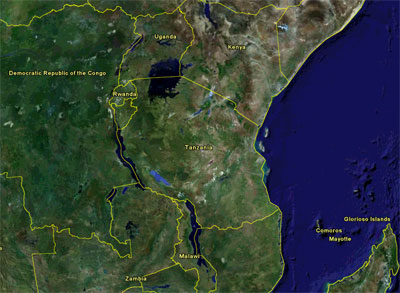TANZANIA
Please note, this page is not longer being updated. For more recent information, please see news.mongabay.com and use the search function to find the country feed. For more up-to-date data on forest cover and loss, check out Global Forest Watch.
| Tanzania Forest Figures
Forest Cover Total forest area: 35,257,000 ha % of land area: 39.9% Primary forest cover: n/a % of land area: n/a % total forest area: n/a Deforestation Rates, 2000-2005 Annual change in forest cover: -412,200 ha Annual deforestation rate: -1.1% Change in defor. rate since '90s: 11.0% Total forest loss since 1990: -6,184,000 ha Total forest loss since 1990:-14.9% Primary or "Old-growth" forests Annual loss of primary forests: n/a Annual deforestation rate: n/a Change in deforestation rate since '90s: n/a Primary forest loss since 1990: n/a Primary forest loss since 1990:n/a Forest Classification Public: 99.8% Private: 0.2% Other: n/a Use Production: 71% Protection: n/a Conservation: 6% Social services: n/a Multiple purpose: 22.9% None or unknown: n/a Forest Area Breakdown Total area: 35,257,000 ha Primary: n/a Modified natural: 35,107,000 ha Semi-natural: n/a Production plantation: 150,000 ha Production plantation: n/a Plantations Plantations, 2005: 150,000 ha % of total forest cover: 0.4% Annual change rate (00-05): n/a Carbon storage Above-ground biomass: 3,636 M t Below-ground biomass: 873 M t Area annually affected by Fire: 9,000 ha Insects: n/a Diseases: n/a Number of tree species in IUCN red list Number of native tree species: n/a Critically endangered: 8 Endangered: 35 Vulnerable: 49 Wood removal 2005 Industrial roundwood: 2,833,000 m3 o.b. Wood fuel: 25,200,000 m3 o.b. Value of forest products, 2005 Industrial roundwood: n/a Wood fuel: n/a Non-wood forest products (NWFPs): n/a Total Value: n/a More forest statistics for Tanzania |
In 2002, the Tanzanian government passed the Forest Act which banned exportation of logs starting in July 2004. However, the regulations were poorly enforced and illegal logging continued apace—by one estimate the country lost 91,000 hectares to illegal felling each year. In early 2006, the Tanzanian government reinforced the export ban logs and sandalwood in an effort to reduce deforestation. The country planted 100 million trees between 1999 and 2006.
Despite 40 percent of the country being preserved in parks, forests are being reduced rapidly in some regions. Overall forest cover fell by 15 percent between 1990 and 2005, but deforestation rates have increased significantly since 2000.
Tanzania's mountainous forests have been in the news lately with the discovery of a new species of monkey and the imminent extinction of a small yellow toad. Overall, Tanzania is home to more than 10,000 species of plants, 316 mammals, 1,056 species of birds, 335 reptiles, 116 amphibians, and 331 species of fish.
Recent articles | Tanzania news updates | XML
Suggested reading - Books
- Lonely Planet Tanzania
- Tanzania Travel Map
- Birds of Kenya and Northern Tanzania
- The Rough Guide to Tanzania
- Two Weeks in a Land Rover: On Safari in Tanzania
- Tanzania, 4th: The Bradt Travel Guide
- The WCS Southern Highlands Conservation Program
Unless otherwise specified, this article was written by Rhett A. Butler [Bibliographic citation for this page]
Other resources
Contact me if you have suggestions on other rainforest-related environmental sites and resources for this country.

Image copyright Google Earth, MDA EarthSet, DigitalGlobe 2005
CIA-World Factbook Profile
FAO-Forestry Profile
World Resources Institute
Last updated: 8 Feb 2006
